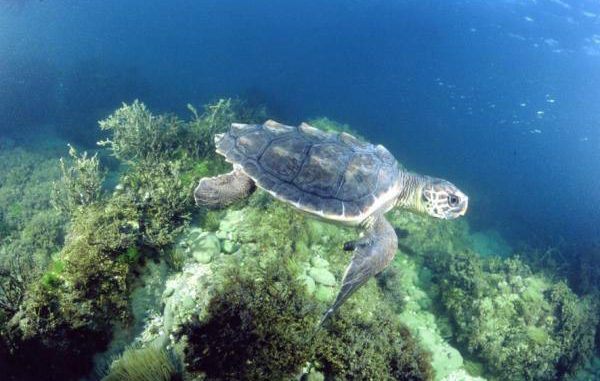
Regulations will take effect on Saturday, May 15
The North Carolina Marine Fisheries Commission voted unanimously at its May 11-13 meeting in Raleigh, adopting new gill-net regulations to settle a lawsuit filed by the Karen Beasley Sea Turtle Rescue and Rehabilitation Center on Topsail Island.
The suit was filed in February by the Duke Environmental Law and Policy Clinic on behalf of the Turtle Rescue and Rehab Center and contended that the N.C. Marine Fisheries Commission, the N.C. Division of Marine Fisheries, Dr. Louis Daniel DMF’s director, were in violation of the Endangered Species Act (ESA) that protects the turtles.
Published reports quoted Jean Beasley, executive director of the turtle center, saying that the agreement offered a real-world, research-based opportunity to try and find a solution to a problem that has been brewing for years. Beasley said many of the new initiatives are based on research into fish and turtle behavior that has been gathered over the years, both in the wild and – in the case of sea turtles – from animals receiving treatment at the turtle hospital.
“The goal was always to preserve the fishing industry in North Carolina and at the same time give sea turtles and other wildlife greater protection,” Beasley said. “We feel this agreement does that.”
Beasley’s sentiments were echoed by Michelle Nowlin, supervising attorney for the Duke Environmental Law and Policy Clinic, which represented the turtle hospital. She said officials on both sides worked hard to develop a settlement that was fair and balanced.
“I think it signals a new day for fisheries management in North Carolina,” Nowlin said, referring to the science-based approach taken in the settlement. “This is something that represents a bona fide compromise that we really worked hard in order to find a middle ground that protects sea turtles, but also protects a viable fishing industry in North Carolina.”
In a press release issued May 13, the Commission announced revised regulations to address interactions with sea turtles in the state’s gill-net fishery and settle the lawsuit A proclamation was issued at the same time declaring that the new regulations will take effect Saturday, May 15, at 6 a.m. and will apply year-round to all large-mesh gill nets (stretched mesh size measuring between four and 6½-inches that are fished as set nets in internal coastal waters, except in the Albemarle and Currituck sounds and their tributaries.
The regulations will not apply to small mesh, run-around, strike or drop nets that are used to surround a school of fish and then are immediately retrieved. Also, the Pamlico Sound Gill Net Restricted Area (PSGNRA) will be exempt from these regulations while it operates under a previously approved Incidental Take Permit (Section 10 Permit) during the September through December 2010 season.
The new regulations for large mesh gill nets include the following provisions targeted specifically at reducing turtle interactions:
• They must be set only on weeknights Monday through Thursday;
• They may be set no sooner than one hour before sunset and must be retrieved (removed from the water) no later than one hour after sunrise the following morning;
• They may be no more than 15 meshes in height;
• They must not be fished without a lead core or leaded bottom line;
• They may not have floats or other buoys except those required for identification north of the B. Cameron Langston Bridge on NC 58 in Emerald Isle.
• Floats will be allowed on nets fished south of the NC 58 bridge in Emerald Isle;
• No fishing operation may use more than a total of 2,000 yards of net in any combination at one time in any waters impacted by these regulations.
• No fishing operation may set more than a total of 1,000 yards of net in any combination at one time south of the N.C. 58 bridge in Emerald Isle;
• No more than 100 yards of net may be set in a continuous line;
• There must be at least 25 yards between separate lengths of net.
For the most part, these are the regulations the Commission voted unanimously to approve at their March meeting. They have been tweaked a little for a couple of area-specific differences in waters that are fished.
Several differences include the hour before sunset to hour after sunrise soak time change from the initial 7 a.m. to 7 p.m. provision, the change to allow floats on nets south of the NC 58 bridge and the change to restrict fishing operations south of the NC 58 bridge to 1,000 yards of total net from the initial 2,000 yards, which will be allowed north of the bridge. The use of floats, but with reduced net yardage is a compromise to allow fishermen to fish in the stronger currents of the southern coastal waters.
“We worked really hard to reach this settlement, and I am proud of all the people involved in the process,” Daniel said. “This allows the commercial fishermen an opportunity to continue fishing in coastal North Carolina waters, while providing good means to protect the sea turtles.”
The Incidental Take Permit (ESA Section 10 Permit) for the PSGNRA will expire in December 2010. NCDMF staff is already working with the National Marine Fisheries Service to secure an Incidental Take Permit for the entire state at that time.




Be the first to comment